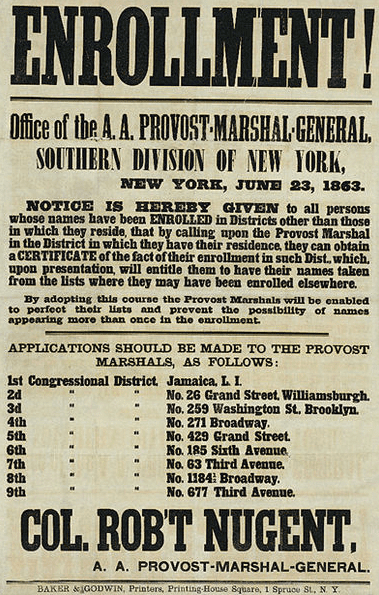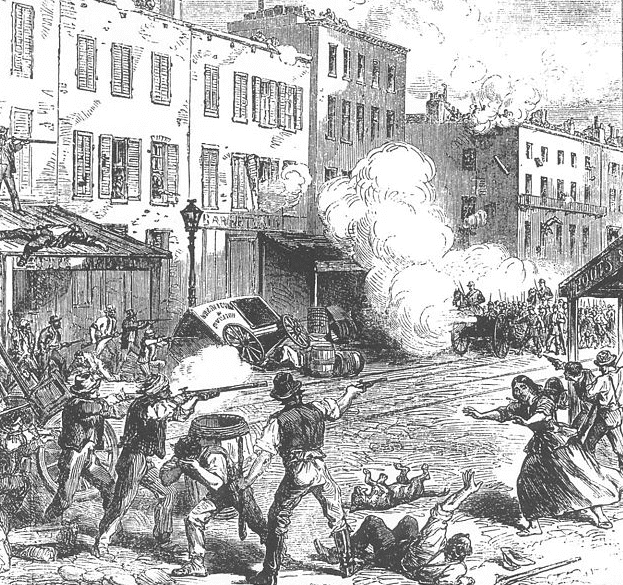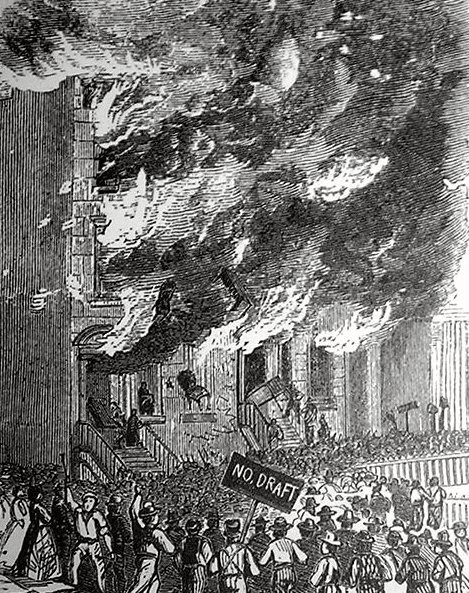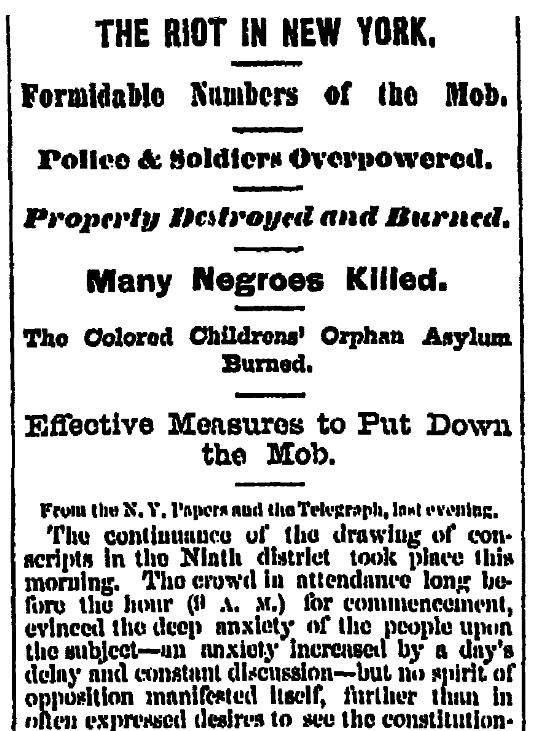In early July 1863, after the Union’s hugely important victory at the Battle of Gettysburg followed by the capture of Vicksburg, Mississippi, it seemed clear that the North had gained the upper hand in the Civil War. One would think that patriotic fervor was then raging in the North, and that support for the war effort was at an all-time high. But, as the following story makes horrifyingly clear, that was not necessarily the case.

With the Union needing more men in early 1863, Congress passed the Conscription Act in March, establishing the first-ever draft in American history. Working-class men resented the fact that the Act allowed wealthy men to escape the draft by paying a $300 fee or hiring a substitute to take their place.
Also, with the Emancipation Proclamation having gone into effect in January, many were angry that the war aims had been expanded from the original goal of restoring the Union to include freeing the slaves. Racial prejudice was not solely a Southern trait in 19th century America.
On 11 July 1863, the first names for the draft were drawn in New York City without any disturbances. However, when the next round of the draft was attempted two days later, a brutal riot broke out with angry mobs roaming the streets, smashing buildings and attacking officials – and turning their fury against any and all Blacks they encountered.

For four days, from 13-16 July 1863, the New York City draft riots raged in the city’s streets. By the time New York state militia and federal troops had restored order, more than 100 people had been killed, as many as a dozen Black men lynched, hundreds – if not thousands – of people injured, and millions of dollars of damage done.

A newspaper reporter was in the room where the draft was taking place on 13 July 1863, the day the riot began. He saw the mob rush in and destroy the equipment, then followed the angry crowd as it tore through the streets, witnessing shocking acts of violence – and he spared his readers none of the details in the first-hand article he wrote.

Here is a transcription of this article:
THE RIOT IN NEW YORK.
Formidable Numbers of the Mob.
Police & Soldiers Overpowered.
Property Destroyed and Burned.
Many Negroes Killed.
The Colored Children’s Orphan Asylum Burned.
Effective Measures to Put Down the Mob.
From the N.Y. Papers and the Telegraph, last evening.
The continuance of the drawing of conscripts in the Ninth district took place this morning. The crowd in attendance long before the hour (9 A.M.) for commencement, evinced the deep anxiety of the people upon the subject – an anxiety increased by a day’s delay and constant discussion…
The ballots were placed in the wheel – a person came in to the reporter’s table, and announced that in the crowd outside were a number of women denouncing the conscription and urging the men to violence at once. The drawing at once commenced, and continued peaceably for some time, but at half past ten o’clock the fury of the mob burst forth in wild cheers again and again.
In a few moments a stone was hurled into the room, and instantly afterward a shower of paving stones and bricks, clearing the room completely, in less than three seconds, of police, officials, reporters, clerks and bystanders. Then the crowd made a rush for the vacated apartment, crushing out every pane of glass, tearing off the doors, smashing tables, entirely destroying the wheel, scattering the ballots, smashing furniture, tearing books and making chaos generally.
One fellow was seen deliberately carrying out a large arm chair and quietly smashing it to the smallest pieces on the pavement.
The mob next tore up the track of the Third Avenue Rail Road, and tore down the telegraph wires for a considerable distance. In a few moments more the flames burst forth in the room. From the rapidity with which they spread it seemed as if camphene, turpentine or some other like combustible had been used to accelerate the flames.
Engine companies were not allowed to approach the conflagration or attempt to stay it. Men were sent to the Fifty-first street bell tower to prevent the giving of the alarm, and fully did their duty. The alarm was given in the crowd that women were in the house, but even this failed to check the infuriated mob.
Lieutenant Vanderpool, Deputy Assistant Provost Marshal, with a courage and humanity which did honor to him, regardless of his uniform, rushed among the crowd and appealed to them to give their exertions to saving the lives of the women and children in the upper stories of the building, but in vain.
The mob, five hundred cowardly brutes, attacked one brave man, beat him with sticks and paving stones until he was almost senseless, and it was only by the great exertions of a few gifted with some little humanity that his life was spared.
The cry now was that the military were coming, and in a few minutes a company of soldiers (the invalid corps, composed of wounded soldiers) made their appearance in the Third avenue. There were only about fifty of them.
The crowd, however, were not deterred, but rushed on the soldiers, disarmed a number of them, and so pressed on others that they were compelled to retreat, which they did slowly, occasionally turning and firing a straggling shot.
The pursuit was kept up as far as 20th street, when it was abandoned, and a majority of the men escaped; one of the soldiers was pursued up 41st street to 1st avenue, where a crowd of some twenty men surrounded him, knocked him down and beat him until he was insensible. A number of women joined in, and one of them endeavored to stab him with a bayonet, but another woman took the weapon out of her hand and carried it off. The soldier was left for dead on the walk, but whether he was so or not could not be ascertained.
Another of the Guard endeavored to make his escape by climbing the rocks near 42d street. No sooner, however, was his intention discovered, than a portion of the mob grabbed him, and taking him to the top of the rocks, stripped his uniform off him, and after beating him almost to a jelly, threw him over a precipice some twenty feet high on to the hard rocks beneath; not content with this, stones and dirt were thrown at him as he lay helpless, until he was half buried.
There is no doubt but that he was killed.
Soon after the defeat of the soldiers a strong squad of police made their appearance in line of battle. As soon as the mob caught sight of them they fired a volley of stones, knocking down two of the officers. The police at once drew their clubs and revolvers, but after a contest of a few minutes they were also forced to retreat, which they did in good order until near Fortieth street, when one of them discharged his revolver four times into the midst of the throng, shooting a horse that was attached to a wagon standing on the corner. A rush was made at once for the officer; he immediately retreated into a store close by, the people in which at once barred the door and endeavored to give him protection. The crowd, however, went to the back of the house, tore down the fence, and rushed into the building, seized the policeman, knocked him down, and actually tore him to pieces – stripping the clothes off his back – and kicking him until he was one mass of jelly.
The most horrible and beastly outrages have been perpetrated. Some twelve or thirteen police have been so brutally treated that recovery is almost hopeless.
About two o’clock Mr. Howard, late city editor of the N.Y. Times, was attacked by the mob, howling “Here is an Abolitionist,” and they were about to hang him to a lamppost, when the mob’s attention was diverted and he ran for his life, the crowd chasing him, striking him on the back of his head and in the face with heavy paving stones, stunning him, when they robbed him of his watch and chain, diamond breastpin and $33. He was with difficulty taken to an engine house, the doors of which resisted the efforts of the mob, and he finally got away. His injuries are very severe.
The mob tore up iron fences to arm themselves, and about three o’clock processions of ruffians and women formed, with clubs, bars of iron, &c., and marched up First avenue, threatening all connected with the conscription.
About four o’clock some 3,000 of the armed mob marched down Fifth avenue groaning for the conscription.
Every negro who has been seen by the mob has been either murdered or horribly beaten. Thus far some twenty have been killed.
The Colored Orphan Asylum has been destroyed by the mob.
Note: An online collection of newspapers, such as GenealogyBank’s Historical Newspaper Archives, is not only a great way to learn about the lives of your ancestors – the old newspaper articles also help you understand American history and the times your ancestors lived in, and the news they talked about and read in their local papers. Did any of your ancestors serve in the Civil War? Please share your stories with us in the comments section.
Related Articles:
